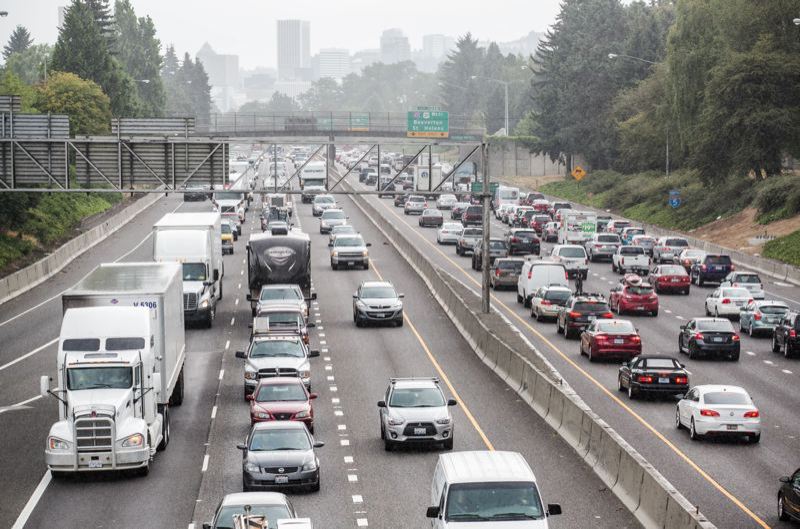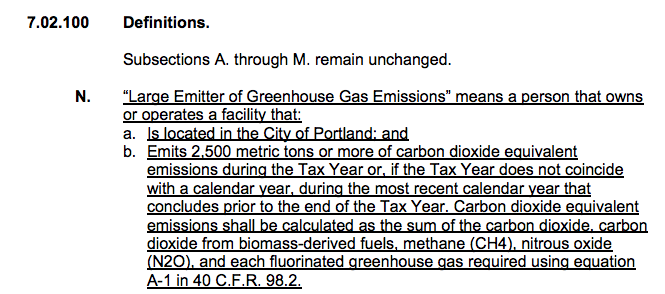By all means, Portland should adopt its proposed healthy climate fee, a $25 ton carbon tax
But make sure it applies to the biggest and fastest growing sources of greenhouse gases in the region
The healthy climate fee should apply to freeways and air travel, not just 30 firms who produce 5 percent of regional GHG emissions.
The City of Portland has proposed a new “healthy climate fee” on a range of businesses and organizations that it says discharge more than 150 tons of greenhouse gases in the city. Like most economists, we’re all on board with the idea of pricing carbon. The reason we have a climate crisis is we allow everyone to use the common atmosphere as a dump for carbon without compensating society for the damage done. Economists are unanimous that pricing carbon is essential to avoiding climate catastrophe: it simultaneously discourages bad behavior, rewards low polluting activities, creates incentives for cleaner investments and spurs the innovation needed to make all this happen. And, as we’ve pointed out the price needed to trigger these changes is modest—less on a per pound basis than the fee we charge for grocery bags or the deposits charged on soda cans or indeed for disposing of solid waste.
The only objection we have to this proposed fee is that it doesn’t go nearly far enough. It exempts more than 95 percent of all the region’s carbon pollution. The proposed climate fee is targeted at those who own or operate facilities that generate 2,500 tons of carbon dioxide or more per year.
The city’s inventory lists 35 such facilities, including steel mills, bakeries, oil storage depots and other manufacturing facilities, but also universities, hospitals, and a wastewater treatment plant. The city has used air pollution permit data to estimate the tax liability of the firms it thinks will be subject to the tax. Collectively, it expects them to pay “healthy climate fees” of about $9.2 million annually on 370,000 tons of carbon emissions.
That seems like an impressive number, but in fact only amounts to about 5 percent of the city’s greenhouse gas emissions. But by its own reckoning, the City of Portland (Multnomah County) produces more than 7.7 million tons of greenhouse gases per year. So this measure taxes small but visible fraction the areas total emissions. What it leaves out is revealing.
As we’ve pointed out repeatedly at City Observatory, Portland is failing in its effort to meet its climate goals because of the big increase in carbon emissions associated with transportation, particularly from increased driving. Transportation accounts for 41 percent of county greenhouse gas emissions, and unlike emissions from residential, commercial and industrial uses, which are all significantly lower than in 1990, these emissions are increasing. In essence, the key reason the city is failing achieve the goals laid out in its 2015 climate plan is due to more transportation emissions. The bulk of the increase is due to increased driving since 2014, when gas prices declined, so this is actually an area where some economic incentives might do some good.
If the region is going to take climate change seriously, it should be focused not just on a handful of institutions that account for less than a twentieth of greenhouse gases, and instead focus on the biggest and fastest growing part of the climate problem. If we think about transportation as a system, it’s clear that the region’s transportation facilities, its freeways and airports are a major source of greenhouse gas emissions. If we’re going to charge such a fee at all, we ought to include in our list of large “facilities” that are even bigger sources of greenhouse gases: the city’s interstate freeways (owned and operated by the Oregon Department of Transportation) and Portland International Airport (operated by the Port of Portland),
Carbon emissions from ODOT Interstate freeways in Portland: 550,000 tons per year
So how much greenhouse gas pollution is produced by ODOT’s interstate freeways in the City of Portland? We don’t have exact data, but we can triangulate a reasonably good estimate. According to the Federal Highway Administration, on an annual (Pre-Covid) basis, there are about 2.9 billion vehicle miles of travel on Interstate freeways in the Oregon portion of the Portland metropolitan area. We apportion this traffic proportional to lane miles of interstate freeway in each county; Multnomah County includes about 53 percent of the tri-county area’s inventory of interstate lane miles, according to ODOT. We further assume that 80 percent of Multnomah County mileage is in Portland. This means that driving on Portland’s interstate freeways amounts to about 1.2 billion miles per year, and at a very conservative passenger car average of .445 kilograms of carbon per mile, produces about 550,000 tons of carbon emissions per year.

If ODOT’s interstate freeways were treated as a “facility” and paid the $25 per ton fee for the emissions from the operation of the facility, it would pay the City of Portland about $14 million per year.
Carbon emissions from Portland International Airport: 1.5 million tons per year
Air travel is a major contributor to global greenhouse gas emissions, and Portland International Airport (aka PDX), the region’s principal air terminal the facility in Portland most closely associated with those emissions. In 2019, according to Federal Aviation Administration data, nearly 20 million passengers flying out of Portland International Airport logged about 11 billion “revenue passenger miles” of travel. Air travel produces about 88 grams of greenhouse gases per revenue passenger kilometer, which means that PDX air travel generated about 1.5 million tons of emissions per year (88 * 11,000,000,000*1.6/1000000). This calculation suggests that PDX is responsible for about three-fourths of one percent of all US aviation greenhouse gas emissions, which total about 200 million tons per year, a figure roughly consistent with the region’s share of US economic activity.

If Portland International Airport were treated as a “facility” and paid the $25 per ton fee for the emissions from the operation of the facility, it would pay the City of Portland about $38 million per year.
Parenthetically: It has to be said that the Port of Portland has a profound blind-spot when it comes to its greenhouse gas footprint. According to the Port’s environmental report, it only counts emissions from its own vehicles, utility plant and purchased electricity, and not from the travel to and from the airport. The port owns up to just 50,000 tons per year in greenhouse gas emissions, just 3 percent of the amount attributable to air travel. Neither does the port count the emissions from the cars that drive to park in its garages. That’s rather like a gun manufacturer counting as “gun deaths” only those people who were pistol-whipped and excluding those killed by bullets.
Let’s have a fair and inclusive Healthy Climate Fee
Together, these two facilities (ODOT’s interstate freeways and PDX) account for more than five times as much carbon pollution than the 35 facilities inventoried by the City of Portland and included in its proposed ordinance. (We believe the city’s own inventory of Portland greenhouse gas emissions significantly undercounts greenhouse gases associated with air travel in and out of PDX).
It’s clear that the city believes it has the authority to impose this fee on local, state and federal governments. It’s proposing to charge the city-owned wastewater plant more than $1 million annually, and also charge state entities (Oregon Health & Science University, the Port of Portland and Portland State University), and even the federal government (the Veterans Administration, which operates a large hospital. The Port of Portland and the Oregon Department of Transportation both own and operate facilities that emit more than 150 tons of greenhouse gases per year. They ought to be subject to the healthy climate fee, too.
In our view, it makes perfect sense of the city to implement a carbon tax or “healthy climate fee.” But if it does, it should do so in a way that applies it to most or all carbon pollution, not just a twentieth of all emissions. The city’s approach to a carbon tax is indefensibly narrow. It gives a pass to the biggest and fastest growing sources of carbon pollution in Portland: transportation emissions. It’s a kind of “carrotism” the notion that climate change can be dealt with without inconveniencing anyone, when in fact, it is all of our daily decisions, especially of how much to drive and fly, that is principally responsible for greenhouse gases. It’s politically convenient to tag a few large, visible polluters, but collectively they’re absolutely smaller than just two entities we’ve identified here, and they’re not the areas where we’re failing to make progress.
A carbon tax makes a huge amount of sense, but exempting 95 percent of all the emissions in the region from the tax, and loading its cost on just a few entities is just arbitrary. If we’re really in a climate emergency, we should apply the carbon fee broadly.
Notes:
- An empty soda can weighs 17 grams; several states impose a 5 cent deposit per can; that works out to a deposit of about $2,900 per ton of can weight). Metro will charge you about $100 ton for the non-recyclable garbage you dispose of, about 5 times what Portland would charge you if you put that same amount of carbon in the atmosphere.
- Carrotism is a term coined by Economist Guilio Matteoli, it is the idea is that “climate change policy should consist entirely of enticing incentives (carrots) avoiding any restriction, regulation or even monetary disincentives (sticks); I.e. we will just glide smoothly into zero-carbon without anyone being inconvenienced ever.”


